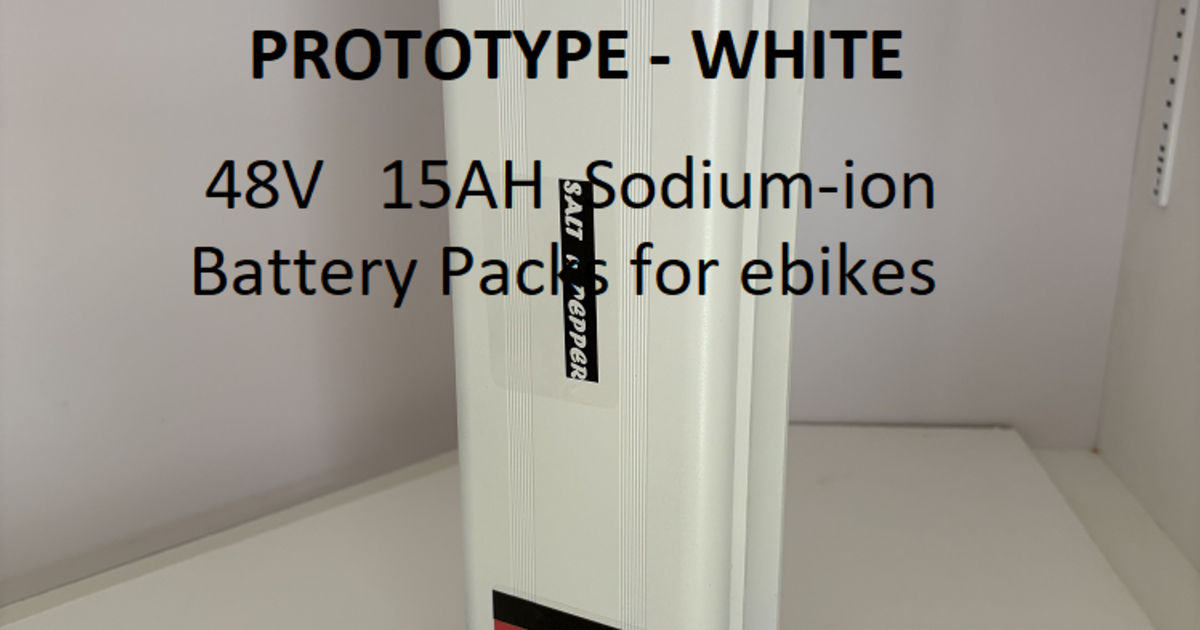
E-BIKE SODIUM ION BATTERY PACKS - SAFE!
Engelhorn Tech introduces our first line of Sodium-ion Battery packs for electric bikes-skateboards. | Check out 'E-BIKE SODIUM ION BATTERY PACKS - SAFE!' on Indiegogo.

I would respectfully disagree, lithium has destroyed thousands of homes around the globe...the future of lithium is months not years. Elon Musk even said "he is switching to sodium-ion battery packs", read the news...I could post hundreds of articles proving sodium-ion is the better choice and future.The benefits to sodium ion seem best when you are comparing to standard Li-NMC (fire, limited cycle life) that we use in ebikes today, but become significantly less attractive when comparing them to LFP.
The few vendors I have seen who announced sodium ion projects very quietly shelved them. The projects never made it to market.
I don't think this is a technology that will see success in the ebike realm, where weight is a significant deterrent. The lower energy density of both LFP and sodium ion creates batteries too heavy to be desirvable versus the more common alternatives.
I would think it would depend on how much weight you're talking about.The benefits to sodium ion seem best when you are comparing to standard Li-NMC (fire, limited cycle life) that we use in ebikes today, but become significantly less attractive when comparing them to LFP.
The few vendors I have seen who announced sodium ion projects very quietly shelved them. The projects never made it to market.
I don't think this is a technology that will see success in the ebike realm, where weight is a significant deterrent. The lower energy density of both LFP and sodium ion creates batteries too heavy to be desirvable versus the more common alternatives.
Well the cells he advertises on his Indiegogo page only have a weight of 37g, versus about 48g for a comparable 18650. So thats good, but they also only have a capacity of 1500mah. Compare an (old school) Panasonic GA cell which a lot of lower cost packs still use, that has a capacity of ... 3450 mah. Yikes one traditional cell stores more than double the energy of the Hakadi 18650's he is advertising for his packs.I would think it would depend on how much weight you're talking about.
I've never been concerned about battery fires or a little extra weight when it comes to Ebikes. I do like the abundance of sodium vs lithium though."the future of lithium is months" is easily, demonstrably false. Painfully so. And the world has decided the limited risk of Li-NMC packs is livable given the very small incidence of fires versus the millions upon millions of packs in use around the globe. We live just fine with highly flammable gasoline tanks whizzing around in cars on the roads, too. Nobody is freaking out about that. If you want to sell your battery packs out of your Venice CA operation, sky-is-falling rhetoric isn't going to get you far.
Sodium ion has a future, but its in the future. Heck, according to your own Indiegogo page you have only been working with the cells you are putting into the packs you are trying to sell for 24 weeks.
Well the cells he advertises on his Indiegogo page only have a weight of 37g, versus about 48g for a comparable 18650. So thats good, but they also only have a capacity of 1500mah. Compare an (old school) Panasonic GA cell which a lot of lower cost packs still use, that has a capacity of ... 3450 mah. Yikes one traditional cell stores more than double the energy of the Hakadi 18650's he is advertising for his packs.
So where does that shake out if you have to use double the cells from one pack versus another, but you are still getting less capacity? Bigger pack. Heavier. Less capacity still and its peak voltage is lower (A 52v pack using these Panasonic cells peaks at 58.8v whereas these Hakadi cells will peak at 56.0v.
I am skipping a lot of details here, but this should be enough to give you the idea. If you aren't afraid of your battery pack exploding because you know the risks, and manage them, then the impetus for putting a battery like this in a bicycle is significantly diminished (and if fire safety and quadrupled lifespan is what you want at the expense of weight, then LFP ebike packs are already out on the market and have been there for years).
Don't get me wrong... I want it to be true that they are a viable alternative. But reality doesn't care what we want, right?I do like the abundance of sodium vs lithium though.

 spectrum.ieee.org
spectrum.ieee.org

 electrek.co
electrek.co
Yeah if you want to see where batteries are going longer-term, just look to the varieties of solid state that are either in the late stages of pilot production, with batches already in the hands of auto manufacturers (QuantumScape, backed by VW and other auto manufacturers being the one that gets most of the press) or are already just beginning full production for inclusion in domestic Chinese electric vehicles.What’s to be gained by the new type of batteries emerging is much greater energy density…lighter weight…a durability that will outlast the owner…safer. I thought this bridge tech coming very soon (months) of a semi-solid state interesting.

For EVs, Semi-Solid-State Batteries Offer a Step Forward
Chinese automakers are rolling out batteries with gel electrolytesspectrum.ieee.org
BYD is the largest EV company in the world. This a venture of theirs in Africa…

How BYD's EV batteries will soon power up tens of thousands of electric motorcycles
Electric motorcycles are likely not the first thing that comes to mind when thinking of BYD, the world’s leading electric...electrek.co